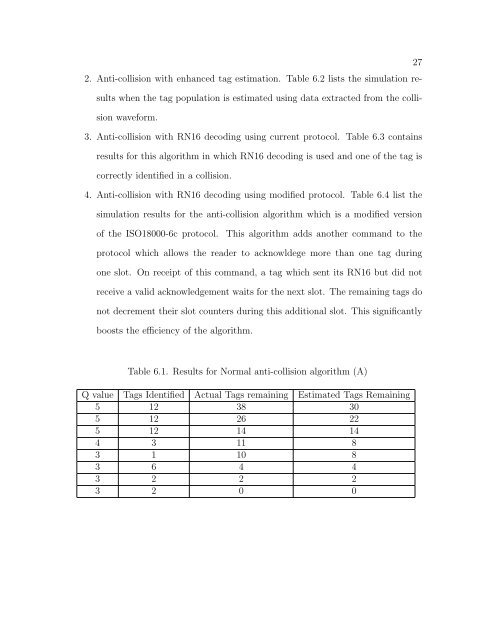utilizing physical layer information to improve rfid tag
utilizing physical layer information to improve rfid tag
utilizing physical layer information to improve rfid tag
You also want an ePaper? Increase the reach of your titles
YUMPU automatically turns print PDFs into web optimized ePapers that Google loves.
2. Anti-collision with enhanced <strong>tag</strong> estimation. Table 6.2 lists the simulation re-<br />
sults when the <strong>tag</strong> population is estimated using data extracted from the colli-<br />
sion waveform.<br />
3. Anti-collision with RN16 decoding using current pro<strong>to</strong>col. Table 6.3 contains<br />
results for this algorithm in which RN16 decoding is used and one of the <strong>tag</strong> is<br />
correctly identified in a collision.<br />
4. Anti-collision with RN16 decoding using modified pro<strong>to</strong>col. Table 6.4 list the<br />
simulation results for the anti-collision algorithm which is a modified version<br />
of the ISO18000-6c pro<strong>to</strong>col. This algorithm adds another command <strong>to</strong> the<br />
pro<strong>to</strong>col which allows the reader <strong>to</strong> acknowldege more than one <strong>tag</strong> during<br />
one slot. On receipt of this command, a <strong>tag</strong> which sent its RN16 but did not<br />
receive a valid acknowledgement waits for the next slot. The remaining <strong>tag</strong>s do<br />
not decrement their slot counters during this additional slot. This significantly<br />
boosts the efficiency of the algorithm.<br />
Table 6.1. Results for Normal anti-collision algorithm (A)<br />
Q value Tags Identified Actual Tags remaining Estimated Tags Remaining<br />
5 12 38 30<br />
5 12 26 22<br />
5 12 14 14<br />
4 3 11 8<br />
3 1 10 8<br />
3 6 4 4<br />
3 2 2 2<br />
3 2 0 0<br />
27
















